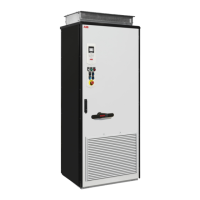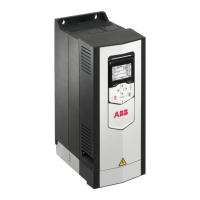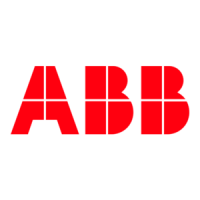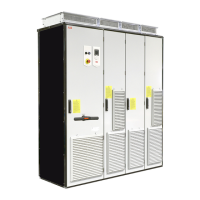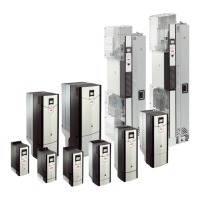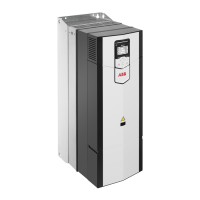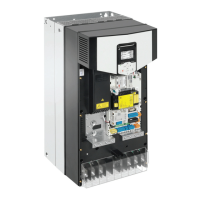Do you have a question about the ABB ACS880-07 Series and is the answer not in the manual?
General safety instructions for all personnel working on the drive.
Specific electrical safety precautions for installation, start-up, and maintenance.
Detailed steps and precautions for ensuring electrical safety during work.
Ensuring the installation site meets ventilation, ambient, and space requirements.
General rules and procedures for securing the cabinet.
General guidelines for cabinet installation and required clearances.
Ensuring compatibility between the motor and the AC drive.
Measures to protect motor insulation and bearings from drive-related stress.
Guidelines for selecting appropriate power cables.
General guidelines for selecting power and motor cables based on regulations.
Recommended power cable types for EMC compliance.
Guidelines for selecting and wiring control cables.
Recommendations for shielding control cables.
General guidelines for routing cables within the system.
General cable routing guidelines according to IEC standards.
General cable routing guidelines for North America.
Protection strategies for drive and cables against short circuits and overload.
Measures for protecting the drive and input power cable during short circuits.
Protection measures for the motor and motor cable against short circuits.
Protection of drive and power cables against thermal overload.
Ensuring motor thermal overload protection as per regulations.
Motor overload protection methods without thermal models or sensors.
Instructions for implementing the emergency stop function.
Guidance on implementing the prevention of unexpected start-up function.
Steps for connecting a motor temperature sensor to the drive.
Details on connecting sensors via option modules.
General safety warnings for electrical installation professionals.
Instructions for measuring insulation resistance.
Warning against performing insulation tests on the drive itself.
Procedure for measuring input power cable insulation.
Steps to measure insulation resistance of motor and cable.
Checks for compatibility with different grounding systems.
Detailed instructions for connecting power cables.
Schematic diagram for power cable connections.
Step-by-step procedure for connecting cables according to IEC standards.
Step-by-step procedure for connecting cables according to US standards.
Detailed instructions for connecting control cables.
Step-by-step procedure for connecting control cables.
Instructions for connecting cables to the control unit.
Wiring for emergency stop push buttons.
General procedure for installing option modules.
Diagram illustrating the default inputs and outputs of the ZCU-1x control unit.
A checklist for verifying mechanical and electrical installation before start-up.
Step-by-step procedure for starting up the drive.
Guidance on interpreting warning and fault messages from the firmware manual.
Annual inspections recommended for optimal reliability and performance.
Procedure for replacing inlet door filters on IP54 cabinets.
Procedure for replacing outlet filters on IP54 units.
Procedure for cleaning the drive module heatsink fins.
Instructions for replacing cooling fans and resetting running time.
Procedure for replacing the fans located on the cabinet door.
Procedure for replacing cabinet fans in frames R6 to R9.
Procedure for replacing main fans of the drive module in frames R6 to R8.
Procedure for replacing auxiliary cooling fans in drive modules (R6 to R9).
Procedure for replacing main fans of the drive module in frame R9.
Procedure for replacing main fans of the drive module in frames R10 and R11.
Procedure for replacing cooling fans in circuit board compartments.
Procedure for replacing IP54 roof fans in frames R6 to R8.
Procedure for replacing IP54 roof fans in frame R9.
Procedure for replacing IP54 roof fans in frames R10 and R11.
Procedure for replacing the drive module in frames R6 to R8.
Procedure for replacing the drive module in frame R9.
Procedure for replacing the drive module in frames R10 and R11.
Procedure for replacing the control panel battery for the real-time clock.
Procedure for transferring parameters by replacing the ZCU-12 memory unit.
Instructions for replacing the ZCU-12 control unit battery.
Procedure for transferring parameters by replacing the ZCU-14 memory unit.
Procedure for replacing the ZCU-14 control unit battery.
Procedure for replacing faulty safety functions modules.
Required clearances around the drive for installation and ventilation.
Recommended power cable sizes for various drive types and current ratings.
Data on terminals and cable entry points for power cables.
Terminal and entry data for power cables according to IEC standards.
Terminal and entry data for power cables according to US standards.
Terminal data specific to control cable connections.
Data related to motor types, voltage, frequency, current, and switching frequency.
Lists compatible motor types for the drive.
Describes the Safe Torque Off (STO) function and its application.
Detailed wiring instructions for the STO connection.
Information on the activation switch component for STO.
Explanation of how the Safe Torque Off function operates.
Procedure for validating the Safe Torque Off function during start-up.
Step-by-step procedure for validating the STO function's operation.
Instructions on how to activate and deactivate the Safe Torque Off function.
Guidance on troubleshooting the Safe Torque Off function.
Provides safety data, including SIL/PL ratings and failure modes.
Guidelines for planning the selection and configuration of the braking system.
Steps for selecting default and custom brake system components.
Procedure for selecting standard drive, chopper, and resistor combinations.
Guidelines for selecting a custom brake resistor, including resistance values.
Measures to protect the system from thermal overload.
Protection for the brake resistor cable against short circuits.
Procedure for measuring insulation resistance of custom brake resistor circuits.
Recommended parameter settings for brake chopper and resistor.
Technical data tables for internal brake choppers and example brake resistors.
General safety instructions for all personnel working on the drive.
Specific electrical safety precautions for installation, start-up, and maintenance.
Detailed steps and precautions for ensuring electrical safety during work.
Ensuring the installation site meets ventilation, ambient, and space requirements.
General rules and procedures for securing the cabinet.
General guidelines for cabinet installation and required clearances.
Ensuring compatibility between the motor and the AC drive.
Measures to protect motor insulation and bearings from drive-related stress.
Guidelines for selecting appropriate power cables.
General guidelines for selecting power and motor cables based on regulations.
Recommended power cable types for EMC compliance.
Guidelines for selecting and wiring control cables.
Recommendations for shielding control cables.
General guidelines for routing cables within the system.
General cable routing guidelines according to IEC standards.
General cable routing guidelines for North America.
Protection strategies for drive and cables against short circuits and overload.
Measures for protecting the drive and input power cable during short circuits.
Protection measures for the motor and motor cable against short circuits.
Protection of drive and power cables against thermal overload.
Ensuring motor thermal overload protection as per regulations.
Motor overload protection methods without thermal models or sensors.
Instructions for implementing the emergency stop function.
Guidance on implementing the prevention of unexpected start-up function.
Steps for connecting a motor temperature sensor to the drive.
Details on connecting sensors via option modules.
General safety warnings for electrical installation professionals.
Instructions for measuring insulation resistance.
Warning against performing insulation tests on the drive itself.
Procedure for measuring input power cable insulation.
Steps to measure insulation resistance of motor and cable.
Checks for compatibility with different grounding systems.
Detailed instructions for connecting power cables.
Schematic diagram for power cable connections.
Step-by-step procedure for connecting cables according to IEC standards.
Step-by-step procedure for connecting cables according to US standards.
Detailed instructions for connecting control cables.
Step-by-step procedure for connecting control cables.
Instructions for connecting cables to the control unit.
Wiring for emergency stop push buttons.
General procedure for installing option modules.
Diagram illustrating the default inputs and outputs of the ZCU-1x control unit.
A checklist for verifying mechanical and electrical installation before start-up.
Step-by-step procedure for starting up the drive.
Guidance on interpreting warning and fault messages from the firmware manual.
Annual inspections recommended for optimal reliability and performance.
Procedure for replacing inlet door filters on IP54 cabinets.
Procedure for replacing outlet filters on IP54 units.
Procedure for cleaning the drive module heatsink fins.
Instructions for replacing cooling fans and resetting running time.
Procedure for replacing the fans located on the cabinet door.
Procedure for replacing cabinet fans in frames R6 to R9.
Procedure for replacing main fans of the drive module in frames R6 to R8.
Procedure for replacing auxiliary cooling fans in drive modules (R6 to R9).
Procedure for replacing main fans of the drive module in frame R9.
Procedure for replacing main fans of the drive module in frames R10 and R11.
Procedure for replacing cooling fans in circuit board compartments.
Procedure for replacing IP54 roof fans in frames R6 to R8.
Procedure for replacing IP54 roof fans in frame R9.
Procedure for replacing IP54 roof fans in frames R10 and R11.
Procedure for replacing the drive module in frames R6 to R8.
Procedure for replacing the drive module in frame R9.
Procedure for replacing the drive module in frames R10 and R11.
Procedure for replacing the control panel battery for the real-time clock.
Procedure for transferring parameters by replacing the ZCU-12 memory unit.
Instructions for replacing the ZCU-12 control unit battery.
Procedure for transferring parameters by replacing the ZCU-14 memory unit.
Procedure for replacing the ZCU-14 control unit battery.
Procedure for replacing faulty safety functions modules.
Required clearances around the drive for installation and ventilation.
Recommended power cable sizes for various drive types and current ratings.
Data on terminals and cable entry points for power cables.
Terminal and entry data for power cables according to IEC standards.
Terminal and entry data for power cables according to US standards.
Terminal data specific to control cable connections.
Data related to motor types, voltage, frequency, current, and switching frequency.
Lists compatible motor types for the drive.
Describes the Safe Torque Off (STO) function and its application.
Detailed wiring instructions for the STO connection.
Information on the activation switch component for STO.
Explanation of how the Safe Torque Off function operates.
Procedure for validating the Safe Torque Off function during start-up.
Step-by-step procedure for validating the STO function's operation.
Instructions on how to activate and deactivate the Safe Torque Off function.
Guidance on troubleshooting the Safe Torque Off function.
Provides safety data, including SIL/PL ratings and failure modes.
Guidelines for planning the selection and configuration of the braking system.
Steps for selecting default and custom brake system components.
Procedure for selecting standard drive, chopper, and resistor combinations.
Guidelines for selecting a custom brake resistor, including resistance values.
Measures to protect the system from thermal overload.
Protection for the brake resistor cable against short circuits.
Procedure for measuring insulation resistance of custom brake resistor circuits.
Recommended parameter settings for brake chopper and resistor.
Technical data tables for internal brake choppers and example brake resistors.
| Series | ACS880-07 |
|---|---|
| Category | DC Drives |
| Type | Industrial drive |
| Control Method | Vector control |
| Cooling Method | Air-cooled or liquid-cooled |
| Voltage Range | 380V to 690V |
| Enclosure Type | IP21, IP54 |
| Communication Protocols | Ethernet, Profibus, CANopen, Modbus |
| Built-in Options | Brake chopper, EMC filter |
| Protection Features | Overvoltage, Undervoltage, Overcurrent |
| Ambient Temperature Range | -10 to +40 °C |
| Relative Humidity | 5 to 95 % (non-condensing) |
